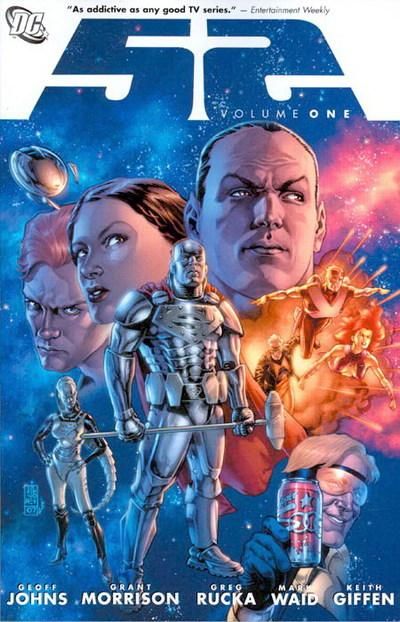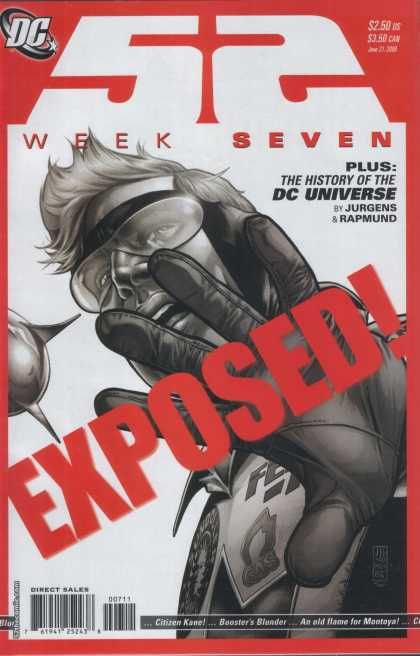Since June is the off month between DC's weekly series, Trinity and Wednesday Comics, I figured it's the right time to do my first multi-part series reading 52. Each week, a different trade collecting 13 issues. Expect spoilers.
52 Vol. 1 by Geoff Johns, Grant Morrison, Greg Rucka, Mark Waid, Keith Giffen, and a whole bunch of artists.
I didn't read 52 really when it was coming out weekly. I was still living at home and my dad was buying it, so I think I tried to give it a shot early on, but it didn't take. I'd flip through it from time to time, but, really, I didn't care. Despite being a big fan of Grant Morrison (and usually enjoying Mark Waid (and having some fondness for Greg Rucka)), it wasn't my thing. I've never been a DC guy. I wouldn't say that I'm a Marvel guy either, but, if you look into my youth at the periods where I focused on a title or character, the only big DC one prior to Morrison's JLA that I can think of is Superman in late 1992/early 1993 when he died and came back. Compare that to extensive obsessions with Thor, Spider-Man (Spider-Clone!), X-Men (Age of Apocalypse, Onslaught), the Avengers (Timeslip, Heroes Reborn, Heroes Return), and a few other books (Cable and X-Force under Jeph Loeb -- seriously)... and, well, I guess I was a Marvel guy by default. My dad bought more Marvel than DC, so maybe that was an influence. I was never not aware of what was going on in DC (or anywhere else, actually). After a certain age (I'd guess around 15 or 16), characters and companies meant little to me as I followed writers. That meant that if I favoured one company over another, it was simply because that company was giving writers I enjoy work. Pretty simple, eh?
As for 52... I didn't pay that much attention. I bought the final issue just because and didn't really enjoy it too much:
All in all, I ended up skimming the issue after fifteen pages because I just didn't give a fuck. My main problem with every issue of 52 that I read was that it read like it was written by committee. I couldn't pick out any real style or anything that made me actually take notice. It was all so mediocre after passing through so many hands. But, that's me.
Of course, that's what you get for buying #52 (of 52) when you've only skimmed previous issues.
In the fall of 2007, I bought the trades for the series from my university's bookstore and did a lovely series of blog posts on them called "I've Got 52 Problems, but a Bitch ain't One... That should get you up-to-date on my previous thoughts regarding the series.
52 volume 1 didn't really do much for me this time around. Okay, that's a lie. Most of 52 volume 1 left me cold. More of it than the last time I read it. There were moments that had me engaged, but a lot of it just flew right past me without me caring. I'll discuss what I liked first...
Super Young Team got a mention in week six! Actually, I really like the Asian superheroes created here. The names sometimes go a bit too far in trying to be "Asian," but the concepts are pretty good. Week six's plot with them, the Green Lanterns and Black Adam is one of the stronger ones in the first 13 issues. More confrontations between the self-appointed galactic policemen Green Lanterns and those under their charge who want nothing to do with them would be nice. As well, recognising that other parts of the world may have a problem with Justice League of America members just coming in and doing as they wish is nice.
Black Adam's plot is one of the few that I enjoyed in every instance it came up. Odd, I know, because I'm not a Geoff Johns fan and this was one of the plots he was more heavily involved with, but it really works in these early stages. Adam is complex and his motivation is relatable.
Alan Scott's obvious trauma once he's returned to Earth is fantastic. His ramblings and attempts to keep it together could have carried on through far more of this book.
Funny how Steel plays a big role in superhero stuff only when certain writers are involved (*COUGH*morrison*COUGH*). His interactions with his niece are well done -- and that Lex Luthor targets him because he's the next best thing to Superman is inspired.
The few scenes with Morrow and Will Magus are great. I love me the mad scientists.
You know, I still love that the art in this volume is consistent despite different artists working on issues. None of the artists really stand out and that's what you want from a book like this. It seems weird, but later volumes suffered, in my opinion, by having really great artists like Phil Jiminez and Darick Robertson aboard, because, then, you noticed how middling the art normally is. The art serves the story and communicates what needs to be communicated... and not much else, and that's a good thing.
There is an exception that, which is my first big complaint: the Question/Montoya plot. I've never enjoyed this plot. I still don't enjoy it. It's the one that I want to skip right over. Part of that, I realised in the shower one morning this week, is the art's fault. The tone of this plot is very different from the others and it's even written differently with Rucka using a lot of nine-panel grids, and scenes that require a darker, noir feeling. In many ways, Rucka writes this plot like the continuation of Gotham Central that it is... forgetting that he doesn't have artists like Michael Lark, Steven Lieber, or Kano to provide the proper atmosphere that works best with this sort of story. The more typical bland superhero house style is great for the other more typical bland superhero plots, but the Question/Montoya one is different and needs to be drawn as such... and it isn't.
Beyond that, the story just doesn't engage me. Intergang bores me. The characters bore me. The commentary mentions the interaction between Montoya and Charlie (the Question), and it just doesn't do it for me. It tries to present one of those odd couples where the bickering is entertaining, but it never really rises above the level of annoying. There are how many plots going on here? If I liked every single one, that would be a goddamn miracle.
The introduction of Batwoman is done alright. The statement that the Kane family owns the half of Gotham the Wayne family doesn't caused me to pause, because I'm not sure if the Kane family had been mentioned in modern continuity prior to this -- and the sudden introduction of major characters in a setting like Gotham always irks me. I understand why it happens since stories sometime require characters who don't already exist, but it doesn't seem any less problematic to have these people who should have, by all rights, been mentioned numerous times before. But, hey, that's me.
Booster Gold's goes through a lot here and it seems like it should be effective and engaging, but it isn't (to me -- last time I add that qualifier here, I promise, but you can never be too careful about telling people that, yes, these are my opinions, not objective facts that I think apply to everyone). It actually seems pretty paint-by-numbers in this volume. Booster is the hero and making money, he wants more money, he's selfish, he goes too far, he's exposed, he's a laughing stock, he resents the brand new hero, he goes searching for something to give him back his edge... it's the sort of story that just seems so obvious with few surprises. The only time that the story rose above this level was when Ralph Dibny showed up and just fucking tore into Booster. That said, the idea of Booster using historical records to make himself into a bigger hero is very quite clever. I would have liked to see it work for longer.
The Ralph Dibny plot is pretty decent, for the most part. I like the Kryptonian resurrection cult aspect, but has there been much follow-up to Wonder Girl's involvement? I can't imagine that other heroes would necessarily want much to do with her after her actions here. The use of Sue Dibny in their ceremony still puzzles me -- why her? Out of all of the people they could attempt to bring back, why would they choose her? It seems like it happens here only to bring Ralph into the plot and give him somewhere to go after this volume.
Ralph is a very relatable character and depicted well here. Where he's left off in this volume is downright creepy and heartbreaking.
Would Steel's niece legally be allowed to participate in Luthor's superhuman program? I assume she's underage here since her uncle wants her to go to summer school... I can't remember if that point comes up later, but it occurred to me.
Despite being one quarter of this series, so much of this book seems like set-up for things that go down later. One aspect of the book that really interests me is its handling of time and, even this early on, you can tell that telling the story in real time just isn't working completely because of the page limit each issue. There just isn't enough room to advance every story as they logically would. Granted, nothing new would happen every week, but some plots are put on hold to give others the needed space. Week 13, for example, is 18 pages of Ralph, two pages of Black Adam and... oh, wait, there's that 20 mark! This isn't meant as a complaint so much as an observation, because what else were the creators to do?
In each of these posts, I also want to spotlight what I think is the best cover of each volume. JG Jones's covers for 52 were consistently spectacular and picking one from each group of 13 is very difficult. My choice for volume 1 is week seven's cover:
See you next week.



